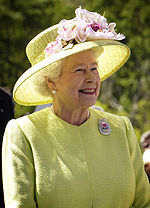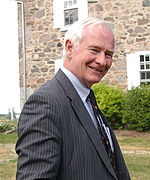- Commander-in-Chief of the Canadian Forces
-
Commander-in-Chief of the Canadian Forces 
Queen Elizabeth II
Governor General David JohnstonType Command Her Majesty's Canadian Armed Forces Eligibility Reigning monarch of Canada, represented by the Governor General of Canada Status Currently constituted Abbreviation C-in-C Precedence Next (lower) Chief of the Defence Staff In Canada, the term Commander-in-Chief of the Canadian Forces (French: Commandant en Chef des Forces Canadiennes) can refer to either the position of supreme commander of the country's armed forces and to the title granted to the viceroy. Constitutionally, command-in-chief is vested in the Canadian sovereign, though these duties have been delegated to the Governor General of Canada, who has consequently been bestowed with the title Commander-in-Chief.[1] By viceregal protocol, the title used with Canadian audiences is Commander-in-Chief of the Canadian Forces and, in international contexts, is Commander-in-Chief of Canada.
Contents
Constitutional provisions, title, and delegation
The Constitution Act, 1867, states that "The Command-in-Chief of the Land and Naval Militia, and of all Naval and Military Forces, of and in Canada, is hereby declared to continue to be vested in the Queen."[2] However, beginning in 1904, the exercise of the duties of the commander-in-chief was transferred to the Governor General of Canada, the monarch's representative in the country. The Militia Act from that year stated that "the Command-in-Chief of the Militia is declared to continue and be vested in the King, and shall be administered by His Majesty or by the Governor General as his representative." Following this, in 1905, the letters patent constituting the Office of the Governor General were amended to read the "Letters Patent constituting the Office of the Governor General and Commander-in-Chief."
 Elizabeth II, Queen of Canada, in her role as Commander-in-Chief of the Canadian Militia and Naval and Air Forces, pictured with the crew of the HMCS St. Laurent in Stockholm, Sweden, 11 June 1956
Elizabeth II, Queen of Canada, in her role as Commander-in-Chief of the Canadian Militia and Naval and Air Forces, pictured with the crew of the HMCS St. Laurent in Stockholm, Sweden, 11 June 1956
Throughout the development of the armed forces, the monarch has remained vested with command-in-chief,[3][4] while the governor general's title altered to suit the changes in the militia's structure. Following the establishment of the Canadian Department of the Naval Service in 1910, the viceroy was styled Commander-in-Chief of the Militia and Naval Forces and, after the creation of the Royal Canadian Air Force in 1918, as Commander-in-Chief of the Militia and Naval and Air Forces. Following this, letters patent issued in 1947 by King George VI referred to the Office of Governor General and Commander-in-Chief in and over Canada.[1][5] In 1968, following the unification of the Royal Canadian Navy, the Canadian Army, and the Royal Canadian Air Force, the commander-in-chief became the senior most officer of the Canadian Armed Forces.
Though all executive power is legally reposed in the Crown, the role of commander-in-chief is primarily symbolic in practice; under the Westminster system's conventions of responsible government, the Cabinet — which advises the sovereign or her viceroy on the exercise of the executive powers — holds de facto decision making power over the deployment and disposition of Canadian forces. Still, all declarations of war are issued with the approval, and in the name, of the monarch, and must be signed by either the sovereign or the governor general, as was done with the proclamation that declared Canada at war with Nazi Germany, issued on 10 September 1939; it stated: "Whereas by and with the advice of Our Privy Council for Canada We have signified Our Approval for the issue of a Proclamation in the Canada Gazette declaring that a State of War with the German Reich exists and has existed in Our Dominion of Canada as and from the tenth day of September, 1939."[6]
In exercising the duties of commander-in-chief, the governor general appoints the Chief of the Defence Staff, as well as royal colonels-in-chief of Canadian regiments (save for the Queen herself), approves new military badges and insignia (except for those bearing St. Edward's Crown, which may only be sanctioned by the monarch), visits Canadian Forces personnel within Canada and abroad, bestowes honours, and signs commission scrolls.[1] Since 2000, the governor general also awards the Commander-in-Chief Unit Commendation to units in the Canadian Forces and allied militias that have performed extraordinary deeds or activities in highly hazardous circumstances in active combat. An insignia pin is presented to members and the unit receives a scroll and may fly a special banner.[7][8]
Rank insignia
Unique Commander-in-Chief rank insignia is displayed on the applicable Canadian Forces uniforms, which the Commander-in-Chief may choose to wear on occasion. In accordance with the Canadian Forces Dress Instructions, the Commander-in-Chief wears a general officer uniform for any of the three environments with, as appropriate or desirable; a flag or general officer hat badge; a special flag or general officer sleeve braid, embellished with the Commander-in-Chief's badge (the crest of the Royal Arms of Canada); and a large, embroidered Commander-in-Chief's badge on the shoulder straps or boards, the badges facing forward.[9]
Commanders-in-chief of the Canadian Forces
Year Sovereign Year Represented by Governor General Commanders-in-Chief of the Canadian Land and Naval Militia 1867 – 1901  Queen Victoria
Queen Victoria1901 – 1910  King Edward VII
King Edward VII1904 – 1910  The Earl Grey
The Earl GreyCommanders-in-Chief of the Canadian Militia and Naval Forces 1910 – 1919  King George V
King George V1910 – 1911  The Earl Grey
The Earl Grey1911 – 1916  Prince Arthur, Duke of Connaught and Strathearn
Prince Arthur, Duke of Connaught and Strathearn1916 – 1919  The Duke of Devonshire
The Duke of DevonshireCommanders-in-Chief of the Canadian Militia and Naval and Air Forces 1919 – 1936  King George V
King George V1919 – 1921  The Duke of Devonshire
The Duke of Devonshire1921 – 1926  The Viscount Byng of Vimy
The Viscount Byng of Vimy1926 – 1931  The Marquess of Willingdon
The Marquess of Willingdon1931 – 1935  The Earl of Bessborough
The Earl of Bessborough1935 – 1936  The Lord Tweedsmuir
The Lord Tweedsmuir1936  King Edward VIII
King Edward VIII1936 1936 – 1952  King George VI
King George VI1936 – 1940 1940 – 1946  The Earl of Athlone
The Earl of Athlone1946 – 1952  The Earl Alexander of Tunis
The Earl Alexander of Tunis1952 – 1968  Queen Elizabeth II
Queen Elizabeth II1952 1952 – 1959  Vincent Massey
Vincent Massey1959 – 1967  Georges Vanier
Georges Vanier1967 – 1968  Roland Michener
Roland MichenerCommanders-in-Chief of the Canadian Forces 1968 – present  Queen Elizabeth II
Queen Elizabeth II1968 – 1974  Roland Michener
Roland Michener1974 – 1979  Jules Léger
Jules Léger1979 – 1984  Edward Schreyer
Edward Schreyer1984 – 1990  Jeanne Sauvé
Jeanne Sauvé1990 – 1995  Ramon John Hnatyshyn
Ramon John Hnatyshyn1995 – 1999  Roméo LeBlanc
Roméo LeBlanc1999 – 2005  Adrienne Clarkson
Adrienne Clarkson2005 – 2010  Michaëlle Jean
Michaëlle Jean2010 –  David Lloyd Johnston
David Lloyd JohnstonSee also
References
- ^ a b c Office of the Governor General of Canada, Role and Responsibilities > Commander-in-Chief, Queen's Printer for Canada, http://www.gg.ca/document.aspx?id=45, retrieved 1 October 2010
- ^ Victoria (29 March 1867), Constitution Act, 1867, III.15, Westminster: Queen's Printer, http://www.solon.org/Constitutions/Canada/English/ca_1867.html, retrieved 15 January 2009
- ^ Canadian Forces Grievance Board (28 August 2006), Canadian Forces Grievance Board, HAR-7088-3119, Ottawa: Queen's Printer for Canada, archived from the original on 7 April 2008, http://web.archive.org/web/20080407040503/http://www.cfgb-cgfc.gc.ca/english/csViewer.asp?x=1#tphp, retrieved 7 February 2008
- ^ Federal Court of Canada (21 January 2008), In the Matter of Aralt Mac Giolla Chainnigh v. the Attorney-General of Canada, T-1809-06; 38, Ottawa: Queen's Printer for Canada, p. 5, 2008 FC 69, http://decisions.fct-cf.gc.ca/en/2008/2008fc69/2008fc69.pdf, retrieved 7 February 2008
- ^ George VI (1 October 1947), Letters Patent Constituting the Office of Governor General of Canada, X., Ottawa: King's Printer for Canada, http://www.solon.org/Constitutions/Canada/English/LettersPatent.html, retrieved 7 June 2006
- ^ George VI (10 September 1939), "Proclamation of a State of War between Canada and Germany", Canada Gazette (Ottawa: King's Printer for Canada) (Extra), http://data2.collectionscanada.gc.ca/ap/c/c140956.jpg, retrieved 16 January 2009
- ^ Office of the Governor General of Canada. "Honours > Other > Commander-in-Chief Unit Commendation". Queen's Printer for Canada. http://archive.gg.ca/honours/hon/02/index_e.asp. Retrieved 17 September 2010.
- ^ Canadian Heraldic Authority. "The Public Register of Arms, Flags and Badges of Canada > Commander-in-Chief Unit Commendation". Queen's Printer for Canada. http://archive.gg.ca/heraldry/pub-reg/project-pic.asp?lang=e&ProjectID=261&ProjectElementID=934. Retrieved 17 September 2010.
- ^ Department of National Defence, Canadian Forces Dress Instructions, Queen's Printer for Canada, pp. 3–7-3, http://www.army.forces.gc.ca/land-terre/downloads-telechargements/reserve/dress-tenue/CF_dress_instructions_mod2008_0514.pdf, retrieved 15 November 2010
 Canadian Forces
Canadian Forces Commander-in-Chief • Chief of the Defence Staff • Armed Forces Council • Chief of the Maritime Staff • Chief of the Land Staff • Chief of the Air Staff
Canada Command • Canadian Expeditionary Force Command • Canadian Operational Support Command • Canadian Special Operations Forces Command • Reserve Force
 Royal Canadian Navy •
Royal Canadian Navy •  Canadian Army •
Canadian Army •  Royal Canadian Air Force
Royal Canadian Air Force Canadian monarchy
Canadian monarchyThe Crown Viceroys Constitutional Queen-in-Council · Queen-in-Parliament · Queen-on-the-Bench · Queen's peace · The Canadian Crown and the Canadian Forces · The Canadian Crown and Aboriginal peoplesLegal Ceremonial and symbolic Related Categories:- Military history of Canada
- Military of Canada
- Monarchy in Canada
Wikimedia Foundation. 2010.




